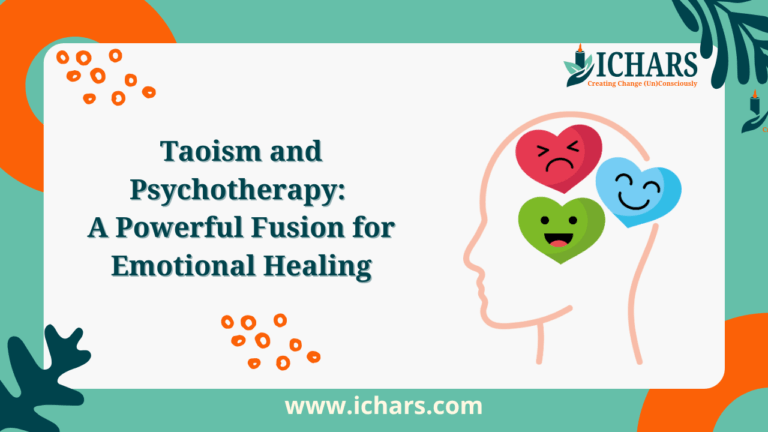Introduction: A New Paradigm for Emotional Wellbeing in Psychotherapy
In an era where psychotherapy is evolving into increasingly integrative models, the fusion of ancient philosophies with contemporary therapeutic techniques offers transformative potential.
Taoism, one of the oldest and most profound philosophical traditions of China, provides a dynamic framework for understanding the human psyche through the lens of balance, natural flow, and harmony.
Integrating Taoism into Cognitive Hypnotic Psychotherapy (CHP)—a holistic, client-centered therapy—can offer a rich, multidimensional approach to emotional wellbeing, providing lasting transformation for individuals seeking deep, authentic healing.
Cognitive Hypnotic Psychotherapy (CHP) itself is a comprehensive methodology that blends hypnosis, cognitive-behavioral strategies, and humanistic approaches to heal both conscious and subconscious emotional pain.
The fusion of Taoist philosophy and CHP offers a deeper layer of healing by addressing the energetic, emotional, cognitive, and spiritual dimensions of the self.
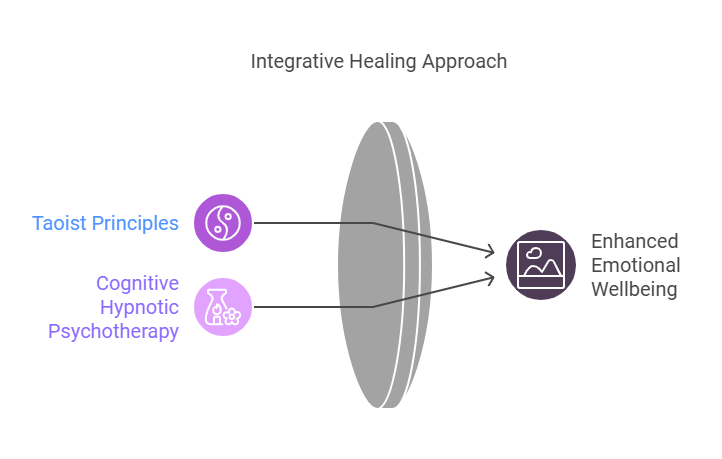
The Tao, with its emphasis on naturalness, balance, and effortless action, resonates deeply with the core objectives of CHP—to help individuals align with their authentic self and achieve sustained emotional balance.
This article aims to provide a deep dive into how Taoist principles can be effectively integrated into CHP.
It will explore advanced therapeutic techniques, theoretical insights, and case studies to demonstrate the transformative power of this fusion, offering a holistic, multidimensional model for therapists and practitioners interested in creating lasting change in their clients’ lives.
The Philosophical Foundations of Taoism: A Deep Understanding of the Self
At its core, Taoism is the art of living in harmony with the Tao, which can be translated as “the Way” or the underlying principle of the universe that guides the flow of all things.
The Tao is ineffable and beyond words, but it is experienced through the rhythm and flow of nature, the balance of opposites, and the deep interconnectedness of all life. The following core Taoist principles are particularly relevant in the therapeutic context:
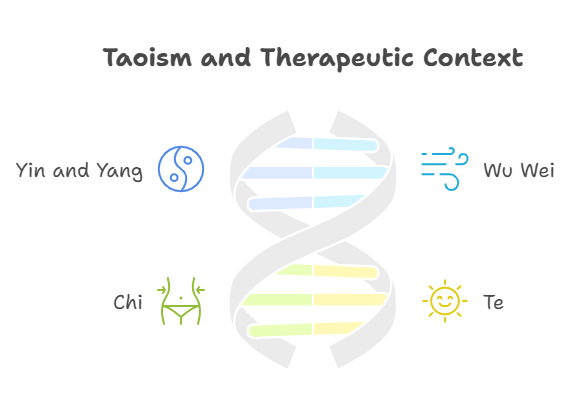
- Yin and Yang: Taoism teaches that all things exist in a state of dynamic balance between complementary opposites. Yin represents qualities such as receptivity, passivity, intuition, and darkness, while Yang represents assertiveness, activity, light, and logic.
Rather than being opposites, they are complementary forces that must coexist and balance each other. In emotional wellbeing, this balance is crucial: feelings of joy and sorrow, anger and calm, light and dark, are all part of the holistic experience of life. - Wu Wei (Effortless Action): One of the most profound teachings of Taoism is Wu Wei, which means “non-action” or “effortless action.” This principle is often misunderstood as passivity, but it is about aligning with the natural flow of life, rather than forcing or struggling.
When applied to psychotherapy, Wu Wei encourages clients to release the need to control or suppress their emotions and to instead allow them to flow freely, with ease and acceptance. - Chi (Qi): Chi is the vital life force that flows through all living beings. In Taoism, it is believed that health—both mental and physical—is achieved when Chi flows freely and without obstruction.
Blockages in Chi can manifest as physical illness, emotional turmoil, or mental distress. In therapy, working with the flow of Chi can help release blockages, restore harmony, and promote healing. - Te (Virtue): Te is the inner virtue or power that arises when an individual is in alignment with the Tao. It is a form of spiritual strength that flows naturally when one is attuned to their true nature.
Te is not something that can be cultivated through effort but emerges from living authentically and in alignment with the natural world.
Taoism in the Context of Cognitive Hypnotic Psychotherapy
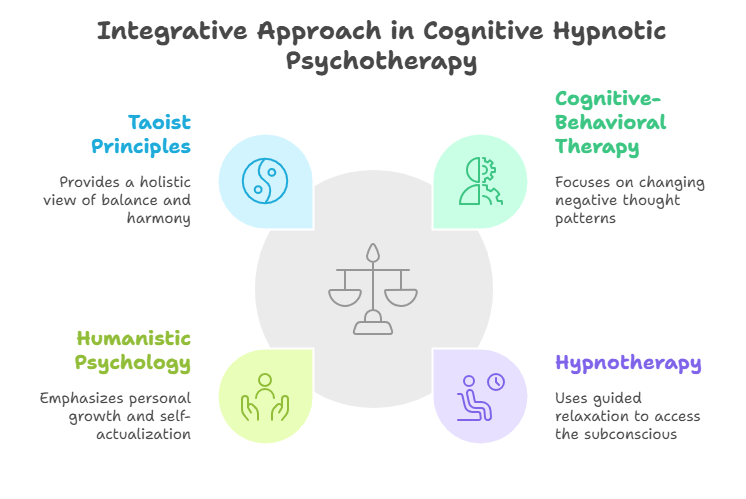
Cognitive Hypnotic Psychotherapy is a powerful, integrative approach that draws from several therapeutic disciplines, including cognitive-behavioral therapy, hypnotherapy, and humanistic psychology.
The purpose of CHP is to help clients access the deeper layers of their psyche—both conscious and unconscious—and address the emotional, cognitive, and behavioral patterns that underlie their struggles.
Incorporating Taoist principles into CHP offers a holistic framework that allows therapists to view the client as more than just a collection of cognitive distortions or behavioral issues.
Instead, clients are understood as energetic beings whose emotional and psychological struggles may be a reflection of imbalances in their inner harmony. By applying Taoist concepts, therapists can help clients reestablish equilibrium and realign with their authentic self.
Practical Integration of Taoist Principles in CHP: Advanced Techniques
The integration of Taoist philosophy into CHP is not simply an intellectual exercise—it involves tangible, actionable techniques that therapists can use to create profound change in their clients. Below, we explore some advanced ways to apply Taoist principles within CHP:
1. Wu Wei and the Power of Non-Resistance
In Taoist thought, Wu Wei refers to the practice of effortless action—acting in alignment with the flow of life rather than against it. In the therapeutic context, this can translate into releasing resistance to emotions, thoughts, or life events.
Application in CHP: In the CHP process, therapists can use hypnotic induction to guide clients into a state of deep relaxation, where they can observe their thoughts and emotions as they arise, without judgment or attachment.
Through techniques such as mindfulness and metaphor-based reframing, therapists help clients let go of their need to control their experiences, creating space for emotional flow. This approach leads to increased emotional flexibility and a reduction in anxiety and emotional repression.
Example: A client experiencing chronic anxiety may be guided in hypnosis to imagine themselves as a river, flowing effortlessly around rocks and obstacles without effort or force. This metaphorical exercise aligns with Wu Wei, teaching the client to navigate life’s challenges with ease and fluidity, rather than rigid control.
2. Yin and Yang: Embracing Emotional Duality
The principle of Yin and Yang encourages the integration of both positive and negative emotional states as natural and complementary aspects of the human experience. Instead of striving to eliminate “negative” emotions, Taoism teaches us to accept all emotions as part of a dynamic whole.
Application in CHP: Therapists can use the concept of Yin and Yang to help clients explore and integrate the full spectrum of their emotions.
In CHP, therapists can guide clients to confront and embrace their darker emotions (e.g., sadness, anger, fear) as necessary components of growth and transformation, while also celebrating their lighter, more expansive emotions (e.g., joy, gratitude, peace).
Example: A client dealing with grief might be encouraged to visualize their grief as a shadow that grows lighter and more transparent when they allow it to coexist with the light of joy, love, or hope. This approach reduces emotional suppression and fosters emotional resilience.
3. Chi: Restoring Flow and Vitality
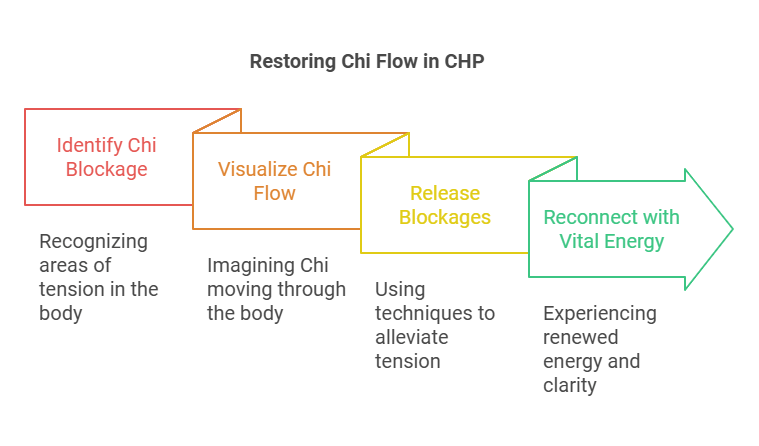
Chi represents the life force that flows through all living beings. In Taoism, health is achieved when Chi flows freely, and blockages in Chi lead to imbalance and illness.
Application in CHP: Working with Chi in CHP involves techniques that help clients reconnect with their inner energy and restore balance. Hypnotic regression, guided visualization, and somatic exercises can be used to release energy blockages and encourage the free flow of Chi.
Example: A client suffering from chronic fatigue or depression may be guided to visualize Chi moving through their body, releasing blockages in areas where they feel tension, such as the shoulders or chest.
This process helps the client reconnect with their vital energy, leading to a sense of renewal and emotional clarity.
4. Te: Cultivating Inner Strength and Virtue
Te, or virtue, is the natural power that arises from living in alignment with the Tao. It is not cultivated through effort or striving, but emerges naturally when one is true to their authentic self.
Application in CHP: In therapy, the cultivation of Te involves helping clients connect with their inner strength and personal wisdom. Hypnotic suggestion, guided imagery, and narrative reframing can help clients tap into their internal resources, leading to enhanced self-efficacy and emotional resilience.
Example: A client struggling with self-doubt may be invited to visualize a wise, compassionate guide who represents their inner strength. Through this visualization, the client accesses their inner Te, reinforcing their confidence and self-worth.
Case Study: Transforming Chronic Depression with Taoist Integration
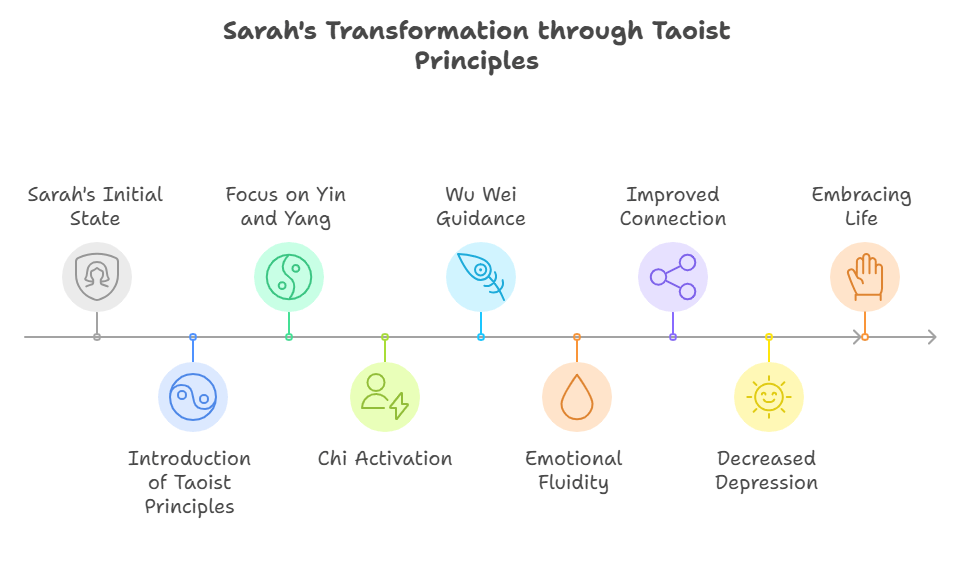
Client: Sarah, a 38-year-old woman, had been battling chronic depression for years, with feelings of hopelessness, emotional numbness, and disconnection from her body.
Intervention: The integration of Taoist principles into CHP began with a focus on Yin and Yang, helping Sarah understand the interplay between her negative emotions (sadness, guilt, fear) and her positive potential (hope, resilience, joy).
Hypnotic techniques helped Sarah tap into her Chi, releasing emotional blocks and reawakening her inner vitality. The principle of Wu Wei guided Sarah to release resistance to her emotions and accept them without judgment.
Outcome: Over several sessions, Sarah began to experience a profound shift. Her emotions became more fluid and manageable, and she reported feeling more connected to both herself and the world around her.
Her depression significantly decreased, and she found herself more capable of embracing life’s challenges with a sense of equanimity.
Conclusion: The Transformative Power of Taoism in CHP
The integration of Taoist principles into Cognitive Hypnotic Psychotherapy offers a profound and holistic approach to emotional wellbeing and transformation.
By combining Taoism’s insights into natural flow, balance, and effortless action with the structured, transformative techniques of CHP, therapists can help clients reconnect with their authentic selves, release emotional blockages, and cultivate deep emotional resilience.
Through advanced therapeutic techniques like Wu Wei, Yin and Yang, Chi, and Te, the therapeutic process becomes more than just about resolving symptoms—it becomes about realigning the whole person with the natural flow of life, unlocking the full potential for healing, self-awareness, and lasting transformation.
For practitioners seeking to create a more comprehensive, holistic approach to emotional healing, the fusion of Taoist philosophy and CHP offers a groundbreaking model for therapeutic practice—one that is deeply rooted in ancient wisdom, yet profoundly relevant to modern psychological work.
